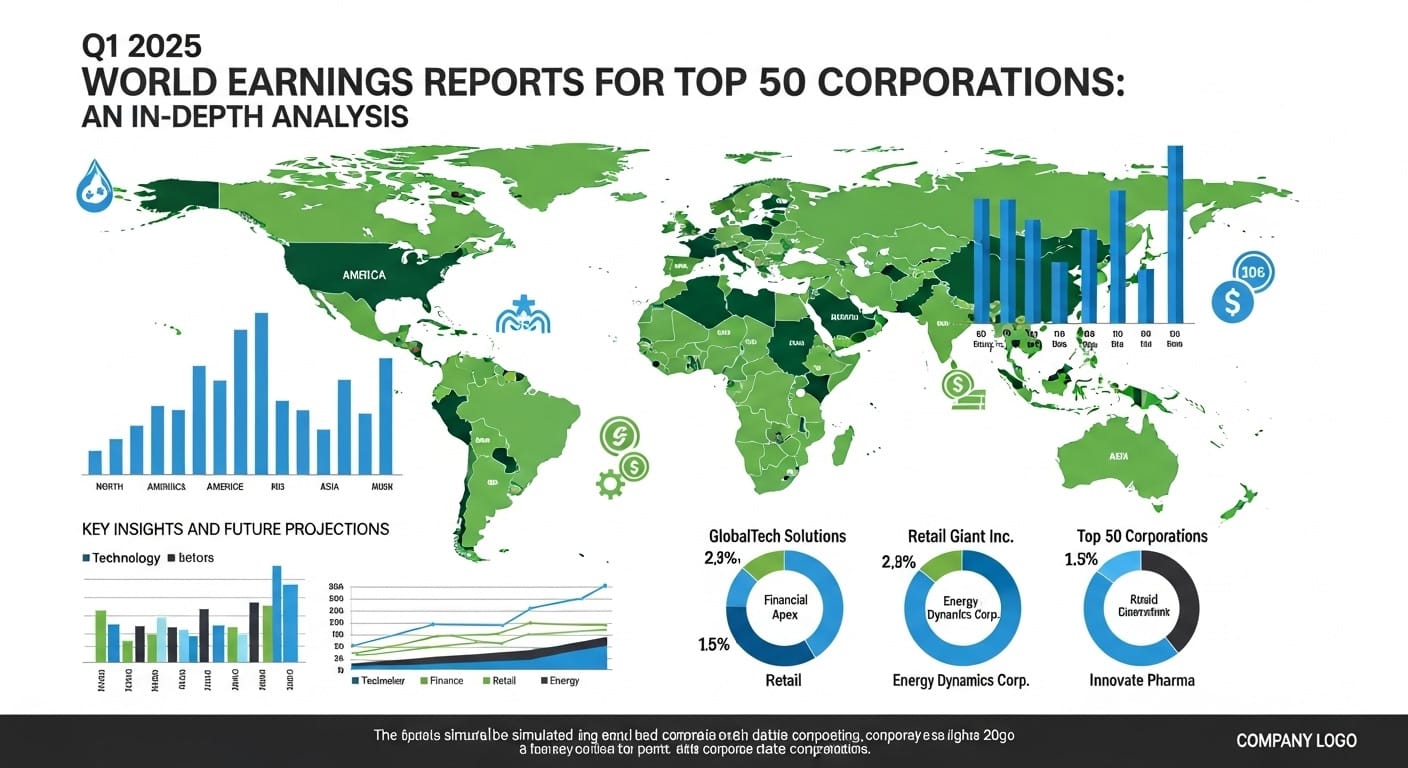The first quarter of 2025 has provided a revealing look into the global economic landscape, highlighting how the world’s leading companies are navigating technological shifts and market uncertainties. The standout theme from this season’s first quarter corporate earnings is the massive investment in Artificial Intelligence (AI), which is fundamentally reshaping strategy and driving growth across all sectors. This analysis breaks down the key findings, financial performances, and strategic directions of major global entities.
Key Financial Highlights: Q1 2025 at a Glance
The following table summarizes the reported financial performance for a selection of prominent corporations during the first quarter of 2025 or their equivalent fiscal period.
| Company | Revenue (Millions) | YoY Revenue Growth (%) | Net Income (Millions) | YoY Net Income Growth (%) | Diluted EPS |
|---|---|---|---|---|---|
| Alphabet Inc. | $90,234 (USD) | 12% | $34,540 | 46% | $2.81 |
| Amazon.com, Inc. | $155,667 (USD) | 9% | $17,127 | 64% | $1.59 |
| NVIDIA Corporation | $39,100 (USD) | 73% | $3,570 (GAAP) | – | $0.76 (GAAP) |
| Taiwan Semiconductor Mfg. Co. Ltd. | NT$839,250 (NTD) | 41.6% | NT$361,560 | 60.3% | NT$13.94 |
| JPMorgan Chase & Co. | $46,000 (USD) | 8% | $14,600 | 10.8% | $5.07 |
| Tencent Holdings Ltd. | RMB180,022 (RMB) | 13% | RMB49,725 (IFRS) | 17% (IFRS) | RMB5.129 |
| Alibaba Group | RMB236,454 (RMB) | 7% | RMB11,973 | 1203% | RMB0.65 |
| Tesla, Inc. | $19,335 (USD) | -9.2% | $420 | -70% | $0.12 |
Note: Some companies report on different fiscal calendars or do not provide all listed metrics. For a complete list of all companies included in the research, please refer to the original paper.
The AI Imperative: A Cross-Sector Investment Boom
The defining trend this quarter is the aggressive push into Artificial Intelligence. Companies are making substantial capital expenditures to build infrastructure and are already reporting tangible returns.
- Alphabet (Google): Capital expenditures for 2025 are projected at $75 billion, primarily for AI support across Google Cloud and DeepMind. AI Overviews in Search are seeing increased usage, and AI Mode queries are twice as long, indicating deeper user engagement.
- Amazon (AWS): The AI business is now a multi-billion dollar annual revenue stream, growing at triple-digit rates. The company is investing heavily in its custom AI chips and models like Bedrock and Amazon Q to accelerate development and handle complex tasks.
- NVIDIA: Data Center revenue soared to $39.1 billion, up 73% year-over-year. The new Blackwell NVL72 AI supercomputer is in full production, and the company views “sovereign AI” (national AI factories) as a major new growth driver.
- Tencent: Capital expenditures are up 91% YoY as the company ramps up AI investments. AI is already contributing to revenue growth in performance advertising and gaming.
- Oracle: Reported a massive $130 billion in Remaining Performance Obligations (RPO), up 62%, driven by cloud services and massive AI data center build-outs.
- Salesforce: Reached over $1 billion in Data Cloud and AI annual recurring revenue, growing over 120% YoY, proving strong customer demand for integrated data and AI solutions.
- Alibaba: Cloud Intelligence Group’s AI-related product revenue has maintained triple-digit growth for seven consecutive quarters, expanding across diverse industries.
Sector Spotlight: Key Trends and Performances
Beyond the overarching AI theme, specific sectors showcased unique dynamics and strategic initiatives.
Healthcare Innovation and Market Dynamics
The healthcare sector is a hub of innovation, with significant advancements in specialized treatments and medical devices.
- Novo Nordisk: Sales of obesity care products (Wegovy®) grew 67%, cementing its position as the global market leader. The company has submitted a next-generation oral obesity treatment to the FDA.
- Roche: Announced a $50 billion investment in U.S. pharmaceuticals and diagnostics over the next five years and is collaborating on a new foundational therapy for overweight and obesity.
- Eli Lilly: Is actively exploring new market segments for its weight loss treatments, including “maintain studies” for patients switching from injectables to oral medications.
- UnitedHealth Group: Reported strong results with revenues of $109.6 billion, up 9.8% YoY, reflecting broad strength across its operations.
Financial Sector: Resilience Amidst Shifting Rates
Major financial institutions showed resilience by adapting to macroeconomic conditions and leveraging digital strategies.
- JPMorgan Chase & Co.: Reported a strong net income of $14.6 billion. While lower rates slightly compressed interest income, this was offset by growth in card balances and investment banking fees.
- Bank of America: Net income grew to $7.4 billion, with its sales and trading division delivering a 12th consecutive quarter of YoY revenue growth.
- Visa: Reported a 9% increase in net revenue, driven by solid growth in service, data processing, and international transaction revenues.
Technology and Manufacturing: Strategic Global Shifts
The tech and manufacturing sectors are making critical investments in next-generation capabilities while navigating geopolitical trade dynamics.
- TSMC: Net revenue surged 41.6% YoY, and net income grew 60.3%, underscoring the relentless demand for advanced semiconductors essential for AI.
- Toyota: The proportion of its electrified vehicles increased significantly to 46.2%, driven by strong Hybrid Vehicle sales. The company is enhancing local production in the U.S. to prepare for potential tariffs.
- Tesla: Faced a challenging quarter with a 9.2% decrease in revenue and a 70% drop in net income, attributed to a decline in automotive sales.
Outlook: AI Investment Defines the Path Forward
The Q1 2025 earnings season paints a clear picture of a corporate world doubling down on innovation to secure future growth. The analysis of the Q1 2025 financial performance from these industry leaders reveals several key takeaways for investors and market watchers.
- Unwavering AI Commitment: Companies see AI not as a feature but as essential infrastructure, akin to electricity. This is leading to record capital expenditures, which may affect short-term profits but is viewed as a necessary investment for long-term competitive advantage.
- Sectoral Strengths: While AI is a universal theme, sectors like healthcare (obesity drugs) and digital services are showing immense, specialized growth. In contrast, others like automotive are undergoing significant market shifts.
- Operational Resilience: From the energy sector’s cost-saving measures to the financial sector’s ability to navigate rate changes, operational efficiency and discipline remain critical.
- The Investor’s Watchlist: The key question moving forward is how effectively these massive AI investments will translate into sustained revenue growth and operational leverage in the coming quarters.











